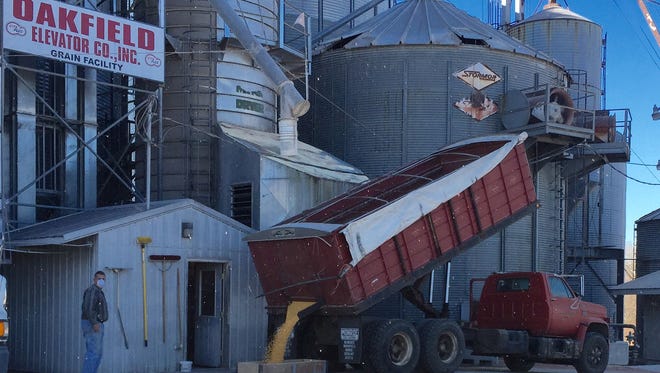Weather and energy shortages playing havoc on drying corn

A wet spring, colder than normal summer and fall weather and now energy shortages due to the cold weather; farmers may be asking what’s next said Scott Sanford, University of Wisconsin-Madison Division of Extension agricultural engineer in the Department of Biological Systems Engineering.
According to U.S. Department of Agriculture’s National Agricultural Statistics Service, 95 percent of corn in Wisconsin reached full dent by Nov. 3, but only 20 percent has been harvested versus 50 percent in a typical year. Much of the corn hadn’t reached maturity before a killing frost hit, which will likely result in lower test weights noted Sanford.
He added, “Harvest is being hampered by wet and snowy fields and now the cold snap has caused propane and natural gas supplies to tighten or not be available for grain drying.”
With the colder than normal temperatures, very little field drying will occur during November or December. Letting corn stand in the field may result in higher losses than if it is harvested and dried. Sanford indicated that a two-year study of field losses found corn left standing after October reported 3-5 percent loss in November, 22 percent in December and if the corn is allowed to stand in the field all winter, a loss of up to 40 percent.
Sanford said farmers should consider the following options.
Do you need to dry the grain?
If the corn is being used for animal feed, it could be stored in bags or a silo as high moisture corn and used before warm weather in the spring.
Storing corn at higher moistures
North Dakota State University grain drying expert Ken Hellevang, indicates that corn can be stored at higher moistures depending on the temperature. Corn at 20 percent moisture and 40°F has an allowable storage time of 90 days while corn at 24 percent has a storage life of 40 days at 40°F. Figure 1 shows the allowable storage life for other moistures and temperatures. The corn must be aerated continuous in the bin at higher moisture levels.
So how can this help?
You could possibly delay drying by one or two months, allowing time for energy supplies to stabilize. You could scout fields and harvest any fields that are 24 percent or less and store them in bins without drying and only dry fields with corn higher than 24 percent until gas supplies become available to resuming drying. You could also dry corn to approximately 20 percent and then cool it and store it until it can be dried further.
If corn kernel temperatures are near freezing, corn with moistures up to 30 percent moisture could be stored in a poly bag and held for 60 days until it can be dried.
Dryer Maintenance
- Spend some time to make sure your grain dryer is working at peak efficiency.
- Clean all screens daily.
- Don’t dry what isn’t salable.
- Screen grains to remove as much foreign matter as possible. This will reduce energy consumption and also reduce the chances of dryer fires. Housekeeping is more critical when outside air temperatures are cold due to condensation occurring on the dryer creating a wet surface for debris to accumulate. The debris may also reduce air flow through the dryer resulting in reduced dryer capacity.
- Check pressure regulators, controls and sensors to make sure they are working accurately.
Dryer operation
The efficiency of drying grain is higher at higher temperatures. According to Hellevang, the amount of energy to remove a pound of water is about 20 percent less at 200°F than at 150°F. The plenum temperatures for a continuous flow dryer are typically in the 180°F to 230°F range.
If the corn moisture is above 25 percent, using higher temperatures in a continuous-flow dryer will reduce drying costs. If you have a multi-stage dryer and wet corn, the first stage could be set at a high temperature and the second stage lower to take advantage of the efficiency of higher drying temperature.
Caution – corn exposed to temperatures above 200°F for more than 2 hours are susceptible to browning or scorching especially for corn that is greater than 30 percent moisture. Drying high moisture corn in 2 passes may be necessary to reduce heat damage. If the corn is dried to 20 percent, it could be put in storage and dried later in the winter or next spring.
Natural-air and low-temperature drying are limited to initial corn moisture contents of about 21 percent. Even at that moisture content, air drying is limited in the northern states due to the colder outdoor temperatures in late October and November. The moisture-holding capacity of air is very small at temperatures below about 40°F. Expect to store the wet corn for the winter by cooling it to 20 to 30°F and finishing the drying in the spring when outside temperatures average above 40°F.
In-bin cooling
Cooling the grain in a bin instead of in the dryer can reduce energy costs by about 15 percent and increase dryer capacity by 20 to 40 percent. Cooling the grain slowing will also reduce kernel stress cracks and can improve test weights compared to rapid cooling in a dryer. The corn would be moved to the storage bin about 1percent to 1.5 percent points above the desired storage moisture content and aerated until it is cooled to the ambient temperature. An aeration fan capacity of at least 0.2 cfm per bushel is required and it will take approximately 75 hours to cool the corn.
With cold temperatures, condensation on the bin walls maybe a problem. This can be remedied by cooling the corn to about 90°F before placing it in the bin or moving the corn to a different bin after cooling to mix any condensation with dry corn so mold formation is reduced. Aerate the grain after moving to into a different bin.
For more information on high-moisture corn drying and storage, go to https://bit.ly/35jpuhO